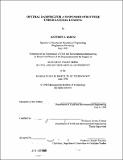Optimal damping for a suspended structure under lateral loading
Author(s)
Kmetz, Matthew J. (Matthew Joseph), 1975-
DownloadFull printable version (16.19Mb)
Advisor
Jerome Connor.
Terms of use
Metadata
Show full item recordAbstract
The design of structural damping systems is an essential component in the design effort for a civil structure. This thesis examines the design and optimization of damping schemes to dissipate the energy input on a suspended structure due to lateral loading. The specific building examined is the suspended structure that was designed by Structures Group A for the purpose of the Master of Engineering High Performance Structures Group Project, Spring, 1998. Specifically, the effect on the building of earthquake loading will be examined. Due to the height of the building, earthquake loads controlled the lateral design. The methodology contained in this report can easily be applied to wind loading also. The design of the damping schemes includes member sizes for the internal lateral bracing for the suspended structure and sizes for the required viscous dampers. The building is analyzed both statically and dynamically to withstand lateral loading in excess of what is associated with Eastern Massachusetts. 3-dimensional computer models that were utilized to approximate the behavior of the structure are included. A rough cost estimate is provided to assist with the comparison of alternatives and to furnish a general idea as to the expense of adding artificial damping to a structure.
Description
Thesis (M.Eng.)--Massachusetts Institute of Technology, Dept. of Civil and Environmental Engineering, 1998. Includes bibliographical references (leaf 59).
Date issued
1998Department
Massachusetts Institute of Technology. Department of Civil and Environmental EngineeringPublisher
Massachusetts Institute of Technology
Keywords
Civil and Environmental Engineering